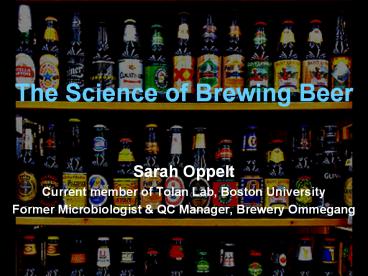The%20Science%20of%20Brewing%20Beer - PowerPoint PPT Presentation
Title:
The%20Science%20of%20Brewing%20Beer
Description:
Sarah Oppelt Current member of Tolan Lab, Boston University Former Microbiologist & QC Manager, Brewery Ommegang * * examples of ales - guiness, any belgian beer ... – PowerPoint PPT presentation
Number of Views:250
Avg rating:3.0/5.0
Title: The%20Science%20of%20Brewing%20Beer
1
The Science of Brewing Beer
- Sarah Oppelt
- Current member of Tolan Lab, Boston University
- Former Microbiologist QC Manager, Brewery
Ommegang
2
The Science of Brewing Beer
- Overview of Brewing Process Ingredients
- What contributes to the flavor of beers?
- Fermentation
- How Yeast is Really Controlling Everything
3
Ingredients
- Water
- Malted Grains
- Hops, or other additives
- Yeast
4
The Mineral Content of Water Will Have Subtle
Effects on Flavor
Ca and Mg (hardness) will effect yeast
metabolism and growth rate
HCO-3 (bicarbonate) will effect the pH of the
fermentation
5
Malted Grain Provides the Sugar for Fermentation
The more roasted a grain is, the more it
contributes toasted and caramel flavors.
However, darker roasted malts provide less simple
sugars.
6
Hops Contribute Bitterness!
Hops are a surficant that also contribute to head
formationbecause of their ability to stabilize
bubbles by increasing surface tension.Our
ability to distinguish levels of bitterness is
very imprecise.
7
Yeast provides all of the flavor!
8
3 Types of Yeast Used in Brewing
Ale yeasts are top-fermenting, can ferment at
higher temperatures, and tend to produce more
esters.
Lager yeasts are bottom fermenting, ferment at
lower temperatures, and produce a more crisp
taste.
Wild yeasts produce a lot of unusual
compounds and contribute to a horse sweat
flavor that is more acidic and an aquired taste.
9
Fermentation in General
10
Major Molecules that Contribute to Flavor
Mouth-feel
Length of carbon chain on alcohol
Amount of alcohol in the beer
Amount and type of esters produced
Residual sulfur compounds
Carbonation
11
Metabolism Involved in Molecules that Contribute
to Flavor
Glucose
DHAP
Glyceraldehyde-3P
G3P
Pyruvate
longer chain alcohols
12
Factors effecting Fermentation
- Mineral Content of Water
- Temperature of Fermentation
- Pitch Rate of Yeast
- Amount of Aeration
- Length of Fermentation
13
The faster a yeast grows and the longer the
exponential growth phase is, the more esters will
be produced.
14
The faster a yeast grows and the longer the
exponential growth phase is, the more esters will
be produced.
15
More Aeration Leads to Less Ester Production
16
Common Esters Their Flavors
Ethyl acetate is the most common ester, and
smells like nail polish remover. However, sensory
threshold for this molecule is very high, so it
isnt usually noticed.
17
Common Esters Their Flavors
Isoamyl acetate has a very low threshold for
detection. It has a fake bananas flavor and is
found in a lot of Belgian and wheat style beers.
18
Common Esters Their Flavors
Isoamyl acetate has a very low threshold for
detection. It has a fake bananas flavor and is
found in a lot of Belgian and wheat style beers.
19
Common Esters Their Flavors
Ethyl butyrate has a low to medium threshold. It
gives hints of passion fruit or pineapple.
20
Common Esters Their Flavors
Ethyl hexonoate has a low to medium threshold. It
lends a red apple or anise like flavor.
21
Budweiser
- Grains Hops Pilsner malt, medium amount of
hops - Yeast S. ovarum, (formerly S. carlsberges)
- Fermentation 15C for 2 wks, with longer
lagering period. Wood chips are added to help
yeast flocculate - Other Filtered beer and force carbonated.
22
Pabst Blue Ribbon
- Grains Hops Pilsner malt, medium amount of
hops, majority of sugar comes from corn - Yeast S. ovarum, (formerly S. carlsberges)
- Fermentation 15C for 2 -3 wks
- Other Filtered beer and force carbonated.
23
Guinness
- Grains Hops dark roasted malts give the color,
light roasted malts provide sugar for
fermentation - Yeast S. cerevisea
- Fermentation 18C for 2 -3 wks
- Other Filtered beer and force carbonated with
nitrogen. The creaminess comes from the feeling
of the smaller bubbles.
24
Hoegaarden
- Grains Hops lighter roasted malts and wheat,
low to medium hops - Yeast S. cerevisea
- Fermentation 18C for 2 -3 wks
- Other Beer is unfiltered and refermented in the
bottle for natural carbonation
25
Rodenbach
- Grains Hops lighter roasted malts and wheat,
low to medium hops - Yeast wild fermentation, spontaneous mixed
culture - Fermentation 18C for 2 -3 wks
- Other Beer is filtered and refermented in the
bottle for natural carbonation
26
Thanks for listening!
Questions?

